A critical View on the New Villa Vauban?
0 Comments Published by Cedric Benetti on Sunday, June 13, 2010 at 6/13/2010 01:50:00 PM.And so, they finally reopened it.
The Villa Vauban, built in 1873 for a wealthy manufacturer, was hosting many important events before being turned into the fine arts gallery of the city of Luxembourg, hosting the painting collections of notable Luxembourgers of the 19th century such as Jean-Pierre Pescatore, Leo Lippmann and Eugénie Dutreux-Pescatore.
The Villa Vauban, built in 1873 for a wealthy manufacturer, was hosting many important events before being turned into the fine arts gallery of the city of Luxembourg, hosting the painting collections of notable Luxembourgers of the 19th century such as Jean-Pierre Pescatore, Leo Lippmann and Eugénie Dutreux-Pescatore.
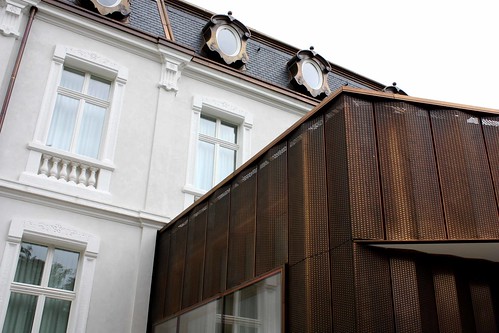
The renovation and adding of a new building annex to the main villa has, according to the press , created a "passionate new dialogue between the old structure and the new addition", which at first sight indeed creates a very catching photo-op. The landscaped park in which the villa is set, was restored to its original state, and the villa itself looks as clean as anything freshly restored this country holds. The possibility of eating off the floors is a must.
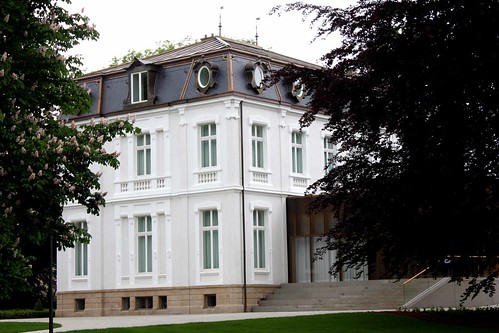
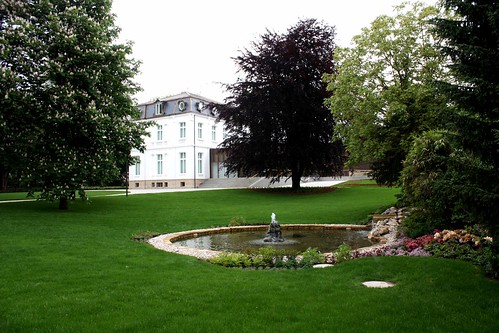
But at first sight, the dialogue of the 2 structures is not the most important feature one notices, as the new addition has ben covered in some mesh that is said to be evolving over time and adapting its color to the wooded park ambiance that surrounds it. Let's build something new, but hide it over time. As for me, I am colorblind, but personally the sight of a dirty brown structure evokes anything but a noble art gallery. Only time will tell if rust will be charming.
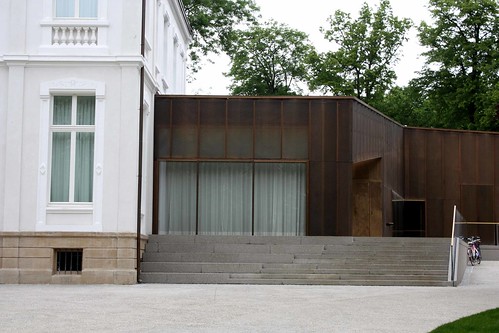
The interior spaces are, for the additon, for once well thought through, and the dimensions clearly state a grand use for future exhibitions. An entire floor has been carved out underground, as well as the fortification wall on which the old villa is partly set, was reconstructed "historically" to please the eye. No photos inside. A shame.
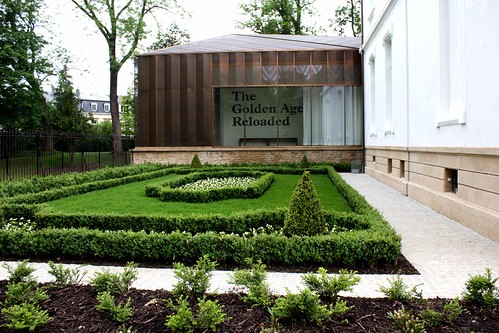
And this no photo policy will clearly stay on, since the museum will be used only for rotating temporary exhibitons of the gallery's holdings and foreign exhibitions on loan. Too bad for those of you that, like myself have been depraved for quite a long time of some of the little masterpieces that the collection holds.
The actual exhibition focusses on dutch and flemish masters of the 17th century. I'm not particularly a fan of the theme, but the exhibiton is very well organized and the behind-the-scenes look at the restoration work is as enlightening for novices as it is for experts in the field. But the fact that the many wonderful pieces of art of the collection, such as the 2 magnificient Canalettos with their views of Venice, are not on display, is a rela shame.
Rotation in exhibitions is a good thing if you want to have your audience keep coming back constantly for new things, as the MUDAM has been proving for a couple of years now, but the organization should have foreseen space for more permanent exhibiton pieces that can be viewed in a more intimate setting.
Bring back some couches and red velvet and contemplate art for arts sake.
The actual exhibition focusses on dutch and flemish masters of the 17th century. I'm not particularly a fan of the theme, but the exhibiton is very well organized and the behind-the-scenes look at the restoration work is as enlightening for novices as it is for experts in the field. But the fact that the many wonderful pieces of art of the collection, such as the 2 magnificient Canalettos with their views of Venice, are not on display, is a rela shame.
Rotation in exhibitions is a good thing if you want to have your audience keep coming back constantly for new things, as the MUDAM has been proving for a couple of years now, but the organization should have foreseen space for more permanent exhibiton pieces that can be viewed in a more intimate setting.
Bring back some couches and red velvet and contemplate art for arts sake.
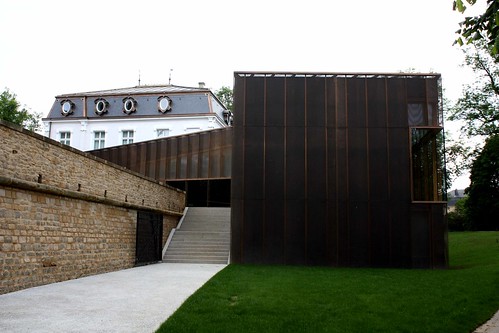
Another, less important thing, is the fact that the rooms inside the historic structure are now finally looking like just any other museum space in the world, as they are stripped off their wainscotting and fireplaces, old style hardwood floors and colored ceilings, that added so much more to the authenticity (even if faked late 19th century authenticity) of the villa. I'm not saying the current rooms are of bad taste, but they blend into the white cube system of any possible museum and have nothing more of their originality, if it isnt for some well preserved stuccoed ceilings. It also seems like some rooms of the original building have been demolished at the back by hiding this fact in the new structure.
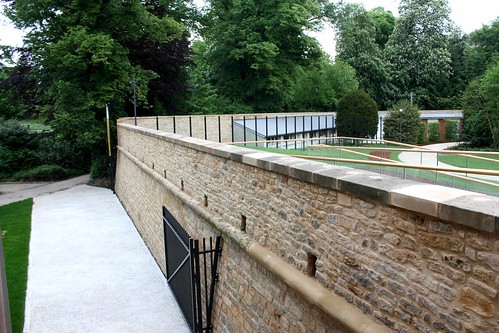
The partly reconstructed fortification wall is a whole other subject for discussion and will not be adressed here.
Let us take another look at the general view of the 2 interconnected structures. Here the recent view:
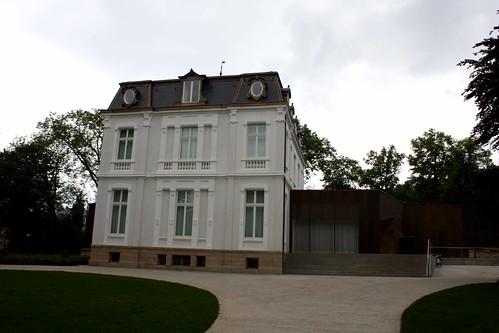
A same view from my archives of the villa in 1996...
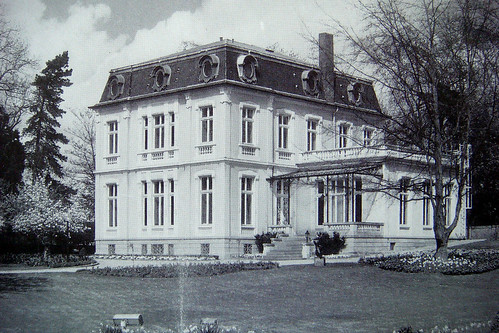
And a more historic view from 1966 of the same.

Notice the tiny but potent differences?
Take a look at the main dormer on the roof of the front façade. It disappears in between decades, and now has reappeared in all its former glory.
Also, try counting the oeuil-de-boeuf style dormers on the side.5 in 66 (on another undated photo I found 2), 3 in 1996, 4 in 2010. Someone has been having fun playing the addition and substraction game here. where did the dormers go?
And for the main question of concern in a heritage oriented way: What happened to the entrace pavillion on the side? The original structure clearly has dissapeared. It is partly still visible inside the new shell, if you try to wring your neck in a bad way and look up inside the new sitting space. And yet it is partly demolished.
Whatever happened to keeping the historic structures intact, if at least from the outside? Why do we have to pass the ugly new entrance door (with automatic opening system, at least something positive) that looks more like something you'd find while accessing the building your dentist lives in?
I rest my case.
I will certainly go back there in the future. The new spaces are a delight for the eyes, and the grand windows on the park are certainly a very inviting space with their benches. And yet, there is the feeling of having something that could have been so much more.
Whatever happened to keeping the historic structures intact, if at least from the outside? Why do we have to pass the ugly new entrance door (with automatic opening system, at least something positive) that looks more like something you'd find while accessing the building your dentist lives in?
I rest my case.
I will certainly go back there in the future. The new spaces are a delight for the eyes, and the grand windows on the park are certainly a very inviting space with their benches. And yet, there is the feeling of having something that could have been so much more.
Labels: Art Galleries, Luxembourg, MUSEUMS, photography
























0 Responses to “A critical View on the New Villa Vauban?”
Post a Comment